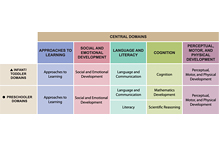The Head Start Approach to School Readiness means that children are ready for school, families are ready to support their children's learning, and schools are ready for children. Learn more about the approach:
- Physical, cognitive, social, and emotional development are all essential ingredients of school readiness.
- Head Start programs view school readiness as children possessing the skills, behavior, and knowledge necessary for success in school and for later learning.
- Programs must establish school readiness goals that are appropriate for the ages and development of enrolled children according to the following Early Learning Outcomes (ELOF) Framework domains:
- Approaches to Learning
- Social and Emotional Development
- Language and Literacy
- Cognition
- Perceptual, Motor, and Physical Development
- Implementing and measuring progress toward school readiness goals helps programs individualize for each child and ensure that children know and can do what is needed to be ready for kindergarten.
- Head Start programs are required to consult with parents in establishing school readiness goals and to respect parents as their children's primary nurturers, teachers, and advocates, as described in the Parent, Family, and Community Engagement (PFCE) Framework.
- As children transition to kindergarten, Head Start programs and schools should work together to promote school readiness and engage families.
The frameworks below provide the foundation for comprehensive child development and family engagement services that lead to school readiness for young children and families.
Frameworks for Understanding School Readiness
School Readiness Goals
The Head Start Program Performance Standards requires all programs to establish school readiness goals, which are are defined as "the expectations of children's status and progress across domains of language and literacy development, cognition and general knowledge, approaches to learning, physical well-being and motor development, and social and emotional development that will improve readiness for kindergarten goals."
Each agency must use the five domains of the ELOF as the basis for school readiness goals. Agencies need to articulate how:
- Their goals appropriately reflect the ages of children participating in the program
- The curriculum and child assessment(s) address or align with the program’s established goals
- Parents were involved in the development of the goals
Head Start programs are expected to:
- Align program school readiness goals with the ELOF and with state and tribal early learning standards, as appropriate
- Create and implement a plan of action for achieving the goals
- Assess child progress on an ongoing basis and aggregate and analyze data three times per year
- Examine data for patterns of progress for groups of children in order to individualize services as well as to develop and implement a plan for program improvement
To help address school readiness requirements, the Office of Head Start will continue to communicate and support programs and will guide the efforts of the Training and Technical Assistance Network. Communications will support programs' continued efforts to build their systems and to deliver quality services to children, families, and communities.
Core Strategies to Promote School Readiness
To help children succeed when they enter school, Head Start programs may implement core strategies such as:
- Implementing an integrated curriculum that addresses the essential domains of school readiness in the ELOF
- Aggregating and analyzing child-level assessment data at least three times per year (except for programs operating less than 90 days, which must do so at least twice within the operating program period) and using that data in combination with other program data to determine grantee progress toward meeting its goals, to inform parents and the community of results, and to direct continuous improvement related to curriculum, instruction, professional development, program design, and other program decisions
- Providing early learning coaching to staff across program options and settings
- Establishing Individualized Wellness Plans that promote healthy development for every child
- Ensuring a parent partnership process that promotes an understanding of their child's progress, provides support, and encourages learning and leadership
- Providing ongoing communication with local schools and other programs receiving Head Start or Early Head Start children, to exchange information about children and programs and to align services for early learning, health, and family engagement
- Creating a learning community among staff to promote innovation, continuous improvement, and integrated services across education, family services, and health
Last Updated: December 23, 2024


